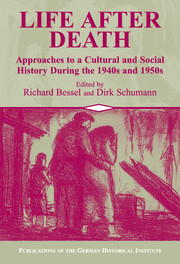Book contents
- Frontmatter
- Introduction Violence, Normality, and the Construction of Postwar Europe
- 1 Post-Traumatic Stress Disorder and World War II
- 2 Between Pain and Silence
- 3 Paths of Normalization after the Persecution of the Jews
- 4 Trauma, Memory, and Motherhood
- 5 Memory and the Narrative of Rape in Budapest and Vienna in 1945
- 6 “Going Home”
- 7 Desperately Seeking Normality
- 8 Family Life and “Normality” in Postwar British Culture
- 9 Continuities and Discontinuities of Consumer Mentality in West Germany in the 1950s
- 10 “Strengthened and Purified Through Ordeal by Fire”
- 11 The Nationalization of Victimhood
- 12 Italy after Fascism
- 13 The Politics of Post-Fascist Aesthetics
- 14 Dissonance, Normality, and the Historical Method
- Index
1 - Post-Traumatic Stress Disorder and World War II
Can a Psychiatric Concept Help Us Understand Postwar
Published online by Cambridge University Press: 05 January 2013
- Frontmatter
- Introduction Violence, Normality, and the Construction of Postwar Europe
- 1 Post-Traumatic Stress Disorder and World War II
- 2 Between Pain and Silence
- 3 Paths of Normalization after the Persecution of the Jews
- 4 Trauma, Memory, and Motherhood
- 5 Memory and the Narrative of Rape in Budapest and Vienna in 1945
- 6 “Going Home”
- 7 Desperately Seeking Normality
- 8 Family Life and “Normality” in Postwar British Culture
- 9 Continuities and Discontinuities of Consumer Mentality in West Germany in the 1950s
- 10 “Strengthened and Purified Through Ordeal by Fire”
- 11 The Nationalization of Victimhood
- 12 Italy after Fascism
- 13 The Politics of Post-Fascist Aesthetics
- 14 Dissonance, Normality, and the Historical Method
- Index
Summary
How far can the pervasive violence of World War II, which affected not only combatants but also civilians, help explain the nature of European societies in the 1950s? The research presented in this book spans several countries and approaches this question from a variety of disciplines. The specific point that this chapter proposes to address is whether the understanding of the individual's reaction to life-threatening violence can contribute usefully to the body of research on the German society of the 1950s. This chapter raises questions and generates new hypotheses or tools for future empirical research. The crucial question remains whether it is at all admissible to use medical concepts to generate hypotheses for historical research.
World War II exposed many individuals to extreme and prolonged violence, and works of fiction as well as historical essays and books attempt to describe the way in which ordinary Germans experienced the war. Wolfgang Borchert's play Draussen vor der Tür captured the atmosphere of the early postwar years. When it was first broadcast on the radio on February 13, 1947, it elicited a tremendous response from listeners. The play describes the guilt, pain, nightmares, and finally suicide of a returned soldier confronted by various people, such as a former officer and the director of a cabaret, trying to forget the war and return to normality. Returning to “normality” was particularly important in the 1950s. Here, the most important question is what lies beneath the surface of this normality and necessitates maintaining it at all costs.
- Type
- Chapter
- Information
- Life after DeathApproaches to a Cultural and Social History of Europe During the 1940s and 1950s, pp. 15 - 36Publisher: Cambridge University PressPrint publication year: 2003
- 6
- Cited by



